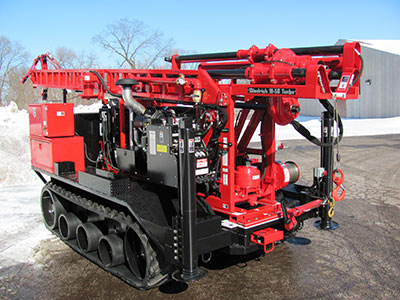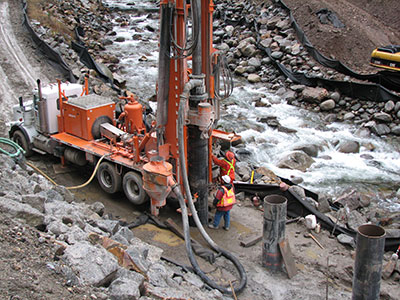
Features
Associations
Business
Geared up
Here’s a sampling of rigs you’ll find at CanWell 2014
April 30, 2014 By Tony Palermo
There’s nothing like a brand new rig to get a driller’s heart a-thumping.
There’s nothing like a brand new rig to get a driller’s heart a-thumping. At this year’s CanWell, attendees will find four companies with new rigs to showcase and a special display of vintage rigs. Here’s a preview of what’s in store.
 |
|
| Diedrich Drill www.diedrichdrill.com – Displaying: D-50 track drill Advertisement
|
Diedrich Drill has been manufacturing drilling equipment for over 40 years. This year, Diedrich will be featuring its D-50 track drill, which geared towards the environmental and geotechnical drilling industry.
The drill frame is welded and constructed of heavy wall rectangular steel tubing. The basic D-50 Magnum unit is powered by a 4-cylinder diesel or a 4-cylinder turbo charged diesel. Other engine options are available. This all-purpose drill rig for soil and rock explorations has a rated depth from 125 ft. to 250 ft. with hollow stem or continuous flight augers up to a 14-inch hole size. And, this rig is rated up to 1000 linear ft. of core drilling using N series tools. It boasts 9100 ft. lbs. of spindle torque. The 2-speed hydrostatic drive, 24 in. wide rubber track system with 16 in. of ground clearance add to its versatility.
Foremost is one of the largest, most geographically diverse manufacturers in Western Canada, specializing in oil and gas, heavy oil, mining, water-well and construction equipment and has been in business since 1965. Foremost will be displaying its DR-24, which is typically used for domestic and municipal wells, construction foundation piling projects and hydraulic elevator jacks.
 |
|
| Foremost Industries – www.foremost.ca – Displaying: DR-24 drill
|
The Foremost Dual Rotary rig is equipped with two rotary drives. A hydraulic top drive comes with a hydraulic tilt-out feature for safe and efficient handling of the drill rods and casing. It rotates the standard drill or reverse circulation string, which can be tooled with a dth hammer, drag bit or rolling cone bit. The primary and distinguishing feature on a dual rotary rig is the independent lower rotary drive used to advance steel casing through unconsolidated overburden. A carbide studded casing, a shoe welded to the end of the first joint of casing, allows the casing string to cut through the overburden. The rotation of the casing by the lower drive provides borehole stability and minimizes stress on the casing welds. Once the casing has been drilled to the required depth, the DR-24 rig can continue to drill open hole in the same manner as a conventional top drive air rotary drill without tripping out the drill string to change the bit. Recent upgrades to the hydraulic system include load sensing pumps, pilot operated directional control valves and joysticks for each system.
Atlas Copco has been in the industry since 1873. This year, Atlas Copco is displaying the TH60 drill rig, which designed to be a robust, reliable water well drill rig built to the highest standards.
The TH60 is designed to be a mid-weight, yet stout and reliable top-head drive PTO drill rig designed for water well, dewatering, geothermal, uranium drilling, and many more deep hole applications. It features a welded cold, finished rectangular, steel tubing construction with a structural capacity of 45,000 lbs. Its maximum working clearance is 37 ft, 5 inches from the hoist line hook to the top of table, and 29 ft. and 2 inches from the bottom of the rotary head spindle to the table with the head at the top of the derrick. An electronic air regulation system comes standard with the TH60, allowing the operator to remain in control of both the flow and the pressure. The intelligent system monitors air requirements and automatically adjusts the air inlet valve to match the demand. Other features include a single, line bare drum lifting capacity of 18,000 lb, 150 ft. cable of 7/8 in. rotation-resistant cable with a 20-ton rod hook, a pulldown capacity of 25,000 lbs and a pullback capacity of 40,000 lbs.
Blast from the past:vintage rigs
There will be two vintage rigs that will be on display at CanWell. One is a 1947 Sullivan rig manufactured by Joy Manufacturing. The truck features a Mercury 3-Ton flathead V8 4-speed transmission and 2-speed rear-end. This rig has drilled water wells and was also used in the seismic drilling programs in Alberta.
Owner John Vlchek recounts an interesting story about the rig’s previous owner, Alex Nicolson. As the story goes, Nicolson had no previous training in drilling with a mud rotary, having only drilled with a wooden cable tool in the Vanderhoof, B.C. area.
“His start in drilling was as a helper on a cable tool that was drilling a well for the Vanderhoof airport,” shares Vlchek. “After acquiring the mud rotary, Nicolson drilled 3 in. wells locally for the farm community in his spare time when he was not doing farm work.”
Vlchek says Nicolson’s knowledge of drilling mud was to put the muddy water from drilling into a barrel and then take it to the next site. His water truck was two 50-gallon barrels in the back of his 3/4 ton Ford truck.
“He would use two barrels in the morning, head to town for lunch, use two barrels in the afternoon, and then back in for pie and coffee before heading home to the farm. All of his drilling logs were in a little black book in his front shirt pocket, detailing all the depths and formations of the wells that he drilled.”
The second rig was built by Henry Peters and Frank Adams in 1971. The Wisconsin engine and the main mechanical drive unit came from an early 1950s New Holland hay baler. The original trailer frame and boom were made from scrap metal, and there were parts from an old car for the axle and transmission. After some early “trial and error” modifications, mainly to the hammer lifting action and stroke length, the rig operated more-or-less unchanged for about 40 years. The trailer frame after was replaced after about 32 years to satisfy Highway Safety regulations.
Print this page